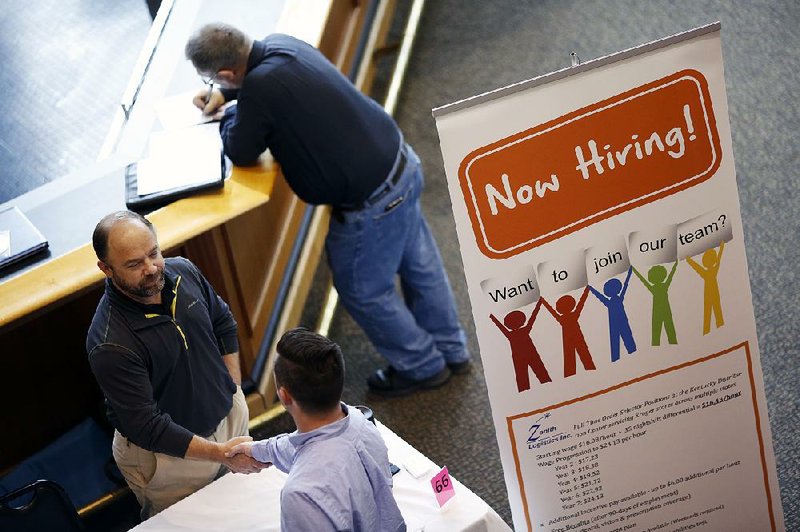WASHINGTON -- U.S. employers added 156,000 jobs in December, capping a year of slower but solid hiring and providing the last major snapshot of the economy President-elect Donald Trump will inherit from President Barack Obama.
Friday's report from the Labor Department portrayed a job market that remains durable 7½ years after the recovery from the recession began. Though the unemployment rate rose to 4.7 percent from a nine-year low of 4.6 percent, it did so for an encouraging reason: More people began looking for work. Because not all of them found jobs immediately, more people were counted as unemployed in December.
"That's a very decent report," Cleveland Federal Reserve Bank President Loretta Mester told Fox Business Network in an interview after the report was released. "We're basically at full employment."
Hourly pay jumped 2.9 percent from a year earlier, the sharpest increase in more than seven years. That is a positive sign that the low unemployment rate is forcing some businesses to offer higher wages to attract and keep workers. Sluggish growth in Americans' paychecks has been a long-standing weak spot in the economic recovery.
"With the unemployment rate down and the labor market tighter, you would expect to see wages move higher, and that's what the data is showing," said Michael Gapen, chief U.S. economist at Barclays. He expects wages to rise by 3.5 percent in 2017, which would be the biggest gain for pay in nearly a decade.
For all of 2016, job growth averaged 180,000 a month, down from 229,000 in 2015 but enough to lower unemployment over time.
"While job growth has slowed somewhat, this is likely more due to a shortage of qualified workers rather than a lack of confidence among business leaders," said Sal Guatieri, a senior economist at BMO Capital Markets.
Hiring last month was led by the health care sector, which added 43,000 jobs, mostly in doctors' offices and hospitals. Manufacturing resumed hiring after four months of job cuts, adding 17,000.
Restaurants and bars gained 30,000 positions. Transportation and warehousing, fueled by the growth of online shopping during the Christmas season, added 15,000. On the other hand, construction and mining companies shed jobs.
A broader gauge of unemployment, which includes part-time workers who would prefer full-time work as well as people who have stopped looking for jobs, dipped to 9.2 percent from 9.3 percent. That's the lowest level since April 2008.
"More people are back at work than at any point since the recession," noted Jed Kolko, chief economist at the job site Indeed. "However, Trump will inherit an economy that's riding high but faces long-term challenges. Fewer adults are at work than before the recession, manufacturing is lagging despite an uptick in December and the acceleration in wage growth, while great for workers, could raise inflation fears."
In addition, many men, especially those without a college education, have suffered as the job market has shifted away from blue-collar work, such as manufacturing and mining, toward industries that either require higher skills, such as information technology, or that pay less and are dominated by women, such as health care.
Though the unemployment rate has returned to its pre-recession level, the proportion of Americans in their prime working years who are either working or looking for work remains far below where it was before the recession began. When people stop looking for a job, they're no longer counted as unemployed. Those "dropouts" have contributed to a declining unemployment rate over the past eight years.
Trump spotlighted that trend as a shortcoming in Obama's record and asserted during the election campaign that the unemployment rate was a "hoax."
Since the election, Trump has successfully pressured several manufacturers to keep some jobs in the United States, including Ford and United Technologies' air-conditioning unit Carrier.
Even so, and despite last month's increase in factory jobs, manufacturing employment declined by 45,000 in 2016.
The steady rise in restaurant, hotel and retail jobs has also increased the ranks of part-time workers who would prefer full-time work. Those industries disproportionately hire part-timers.
About 5.6 million people work part time but want full-time work, a big improvement since the recession. Yet that figure is still well above pre-recession levels of about 4.4 million.
Information for this article was contributed by Christopher S. Rugaber and Josh Boak of The Associated Press; by Nelson D. Schwartz of The New York Times; and by Shobhana Chandra of Bloomberg News.
Business on 01/07/2017
